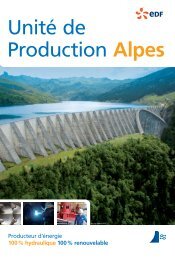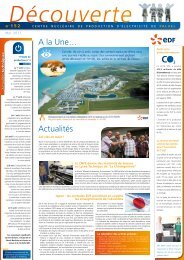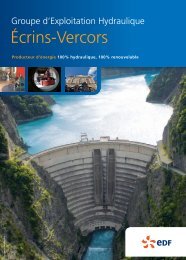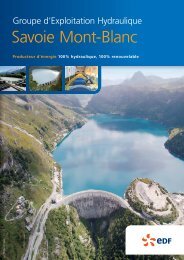Hydroelectric energy - Energie EDF
Hydroelectric energy - Energie EDF
Hydroelectric energy - Energie EDF
You also want an ePaper? Increase the reach of your titles
YUMPU automatically turns print PDFs into web optimized ePapers that Google loves.
How<br />
a hydro plant<br />
works<br />
The principle is simple and relies on the force of gravity:<br />
potential <strong>energy</strong> from water contained in dams is<br />
converted into mechanical <strong>energy</strong> by means of a turbine,<br />
which is in turn converted into electrical <strong>energy</strong> using a<br />
generator.<br />
The dam is used to store up large quantities of water by<br />
forming a lake (1). When the sluice gates are opened, the<br />
water fl ows into a penstock or channel (2) which directs it<br />
towards the power plant. The water causes the turbine to<br />
rotate (3). The turbine drives the generator (4), which<br />
generates electrical current. This current is rectifi ed by a<br />
transformer (5) before being transmitted along highvoltage<br />
power lines. Outside the power plant, the water<br />
returns to the river via the tail-race (6).<br />
HOW A HYDRO PLANT WORKS<br />
Storage reservoir<br />
1<br />
Tunnel<br />
Dam<br />
2<br />
Penstock<br />
3<br />
Turbine<br />
4<br />
Generator<br />
5<br />
Transformer<br />
6<br />
Different plants for different<br />
landscapes<br />
Hydro plants come in a<br />
variety of forms, depending<br />
on the layout of the<br />
waterway, the terrain or the<br />
water head:<br />
– Mountain sites with a steep<br />
gradient, such as the Portillon<br />
plant in the Pyrenees (1,420 m<br />
head in a penstock), but with<br />
a low fl ow rate;<br />
– Medium-head plants with a<br />
higher fl ow rate;<br />
– Run-of-river plants, with a<br />
slight gradient (10-15 m) but a<br />
very high fl ow rate, as found<br />
in large rivers (Rhine, Rhône,<br />
Isère, Durance, etc.);<br />
– Pumped-storage plants,<br />
pumping water downhill<br />
during peak periods and<br />
pumping water uphill during<br />
quiet periods;<br />
–Tidal plants, such as la Rance<br />
in Ille-et-Vilaine, driven by the<br />
tides.<br />
Depending on the type of<br />
dam (arch dam, weight,<br />
abutments, rock fi ll or earth<br />
dam, moveable dam, high,<br />
medium or low-head dam),<br />
three types of turbine are<br />
essentially used: Pelton,<br />
Francis and Kaplan<br />
respectively.<br />
DID YOU KNOW?<br />
AVAILABLE CAPACITY<br />
Available capacity (kW) is a<br />
combination of two factors:<br />
water head (m) and derived<br />
fl o w ( m 3 /s).<br />
09

















